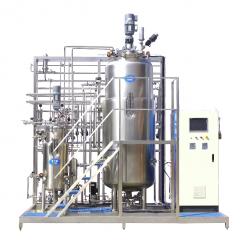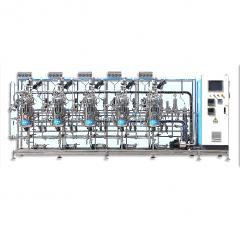
The whole plant is "disassembled" into single cells or cell clusters, which are placed in special jars to allow them to grow like microorganisms in suspension, so as to efficiently and controllably produce pharmaceutical ingredients, natural pigments, essence or other high-value metabolites.
Core description
1. Structural characteristics
• Tank body: 316L stainless steel or high borosilicate glass, jacket temperature control, Ra ≤ 0.4 μ m mirror polished, can be sterilized under high pressure.
Low shear stirring: spiral belt impeller, magnetic suspension paddle or air lift/bubble design, with a speed of 20-120 rpm, to protect fragile cell walls.
• Lighting module: Built in LED or external fiber optic, adjustable light intensity from 0-300 μ mol · m ⁻² · s ⁻¹, meeting the needs of photosynthetic cells.
• Online monitoring: full parameter closed-loop control of pH, dissolved oxygen, temperature, turbidity, foam, and tail gas O ₂/CO ₂.
2. Operation mode
Batch, replenishment or continuous infusion; Liquid filling coefficient 65-80%; The cultivation period is 7-30 days.
Can be used in combination with immobilized carriers (calcium alginate, hollow fiber membranes) to achieve high-density and continuous harvesting.
Main advantage
1. Low shear: Specially designed with paddle and gas circulation, the shear force is only 1/3-1/5 of that of traditional fermentation tanks, and the cell survival rate is>90%.
2. High value products: not limited by season or region, can be selectively induced to synthesize paclitaxel, ginsenosides, anthocyanins, etc., with a content that can reach 2-10 times that of the plant.
3. Small footprint and short cycle: A 30 m ³ reactor yields approximately hundreds of acres of farmland, and can be harvested in 2-4 weeks.
4. Green and safe: No pesticide residue or heavy metal risks, traceable production process, in compliance with GMP/organic certification requirements.
one-sentence summary
The plant cell reactor is a precision fermentation tank with low shear and light exposure, which brings the field into the laboratory and replaces the entire plant with a cell "factory" to safely and efficiently produce natural high-value products.










